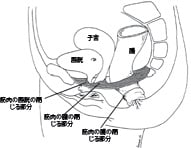What are the pelvic floor muscles?The floor of the pelvis is made up of layers of muscle and other tissues. These layers stretch like a hammock from the tailbone at the back, to the pubic bone at the front. A woman’s pelvic floor muscles support her bladder, uterus (womb) and bowel (colon). The urethra (urine tube), the vagina, and the rectum (back passage) all pass through the pelvic floor muscles. Pelvic floor muscles help control your bladder and bowel. They may also help sexual function. It is vital to keep your pelvic floor muscles strong. |
骨盤底筋とは?骨盤底は、筋肉の層とその他の組織で構成されています。これらの層は背中の尾骨から前部の骨盤までハンモックのように伸びます。 女性の骨盤底筋は、膀胱、子宮、および腸(結腸)を支えます。尿道、膣、および肛門はすべて、骨盤底筋を通ります。骨盤底筋は、膀胱と腸をコントロールする役割を果たします。性的な機能にも関わっています。 骨盤底筋を鍛えておくことは非常に重要です。 |
|
|
|
|
Pelvic floor muscles can be made weaker by:
|
骨盤底筋は、以下の理由で弱くなります。
|
Should I do pelvic floor muscle training?When the pelvic floor muscles have to support heavy loads they may not be strong enough. Heavy loads press down on the pelvic floor muscles when you:
Women who wet themselves when they cough, sneeze or are active have stress incontinence. They will find pelvic floor muscle training can help improve this problem. For pregnant women, pelvic floor muscle training will help the body support the growing baby. Pelvic floor muscle training will also reduce the chance of having a bladder or bowel problem after birth. Healthy muscles before the baby is born return to normal more easily after birth. After the birth of your baby, begin pelvic floor muscle training as soon as you can. Always brace your pelvic floor muscles. To brace means to squeeze up your pelvic floor muscles and hold before you cough, sneeze or lift the baby. This is called having ‘the knack’. As women grow older, the pelvic floor muscles need to stay strong. After menopause, hormone changes can affect bladder control. As well as this, the pelvic floor muscles change and may get weak. A pelvic floor muscle training program can help to lessen the effects of menopause on pelvic organ support and bladder control. A pelvic floor muscle training program may also help women who have an urgent need to pass urine often. |
骨盤底筋のトレーニングをするべきですか?骨盤底筋に重い負担がかかると、(下腹部の臓器を)支え切れなくなることがあります。以下の場合に、骨盤底筋に重い負担がかかります。
緊張性尿失禁の女性は、咳、くしゃみ、または運動をするときに尿漏れします。骨盤底筋のトレーニングにより、この問題を改善することができます。 骨盤底筋トレーニングは、妊婦が成長している胎児を支えるのに役立ちます。骨盤底筋のトレーニングにより、出産後、排尿または排便の問題が発生する可能性が低くなります。出産前に骨盤底筋が健全であると、出産後も通常の状態に戻りやすくなります。 出産後、できるだけ早く骨盤底筋トレーニングを開始してください。骨盤底筋を常に構えた状態にします。つまり、咳、くしゃみをする、または赤ちゃんを持ち上げる前に骨盤底筋を締め付けます。これが「コツ」です。 年齢が上がると、骨盤底筋を強化する必要がります。更年期以降、ホルモンの変化により排尿コントロール機能に影響が及び、さらに骨盤底筋が変化して弱くなることがああります。骨盤底筋トレーニングプログラムにより、 骨盤組織のサポートと排尿コントロールに対する更年期による影響を軽減できます。 骨盤底筋トレーニングプログラムは、尿意切迫感にお困りの 女性にとっても役立ちます。 |
Where are my pelvic floor muscles?The first thing to do is to find out which muscles you need to train. Here are two things you can try.
If you do not feel a distinct ‘squeeze and lift’ of your pelvic floor muscles when you try to squeeze, ask for help from a continence physiotherapist or continence nurse advisor. They will help you to get your pelvic floor muscles working the right way. Even women with very weak pelvic floor muscles can be helped by pelvic floor muscle training. |
骨盤底筋はどこにありますか?最初にするべきことは、鍛える必要がある筋肉がどこにあるかを見つけることです。ここに2つの方法があります。
骨盤底筋を締め付けようとするときに、「締め付けて持ち上げる」感覚が明確に得られない場合、失禁理療療法士または失禁看護アドバイザーに助けを求めてください。骨盤底筋が適切に機能するよう支援サービスを提供しております。 骨盤底筋が弱い女性でさえ、骨盤底筋トレーニングがお役に立ちます。 |
How do I do pelvic floor muscle training?Now that you can feel the pelvic floor muscles working, you can:
While doing pelvic floor muscle training:
|
どのようにして骨盤底筋のトレーニングをするべきですか?骨盤底筋が動くのを感じることができたら、次のことが可能です。
骨盤底筋トレーニングをしているときは:
|
Do your pelvic floor muscle training the right wayFewer hard squeezes are better than a lot of half-hearted ones. Ask for help from your continence physiotherapist or continence nurse advisor if you are not sure you are doing the squeezes right. Seek help if you do not see a change in your symptoms after 3 months. |
骨盤底筋トレーニングを正しい方法で実行してください中途半端に何度も締めるよりも、数回だけ強く締めてください。正しく締めているかどうかわからない場合は、助けを求めてください。失禁物理療法士または失禁看護アドバイザーにお聞きください。 3か月トレーニングを続けても症状が変わらない場合は助けを求めてください。 |
Make the training part of your daily lifeOnce you have learnt how to do pelvic floor muscle squeezes, do them often. Every day is best. Give each set of squeezes your full focus. Make a regular time to do your pelvic floor muscle squeezes. This might be after going to the toilet, when having a drink or when lying in bed. Other things you can do to help your pelvic floor muscles:
|
トレーニングを日課にしてください骨盤底筋を締める方法を学んだら、より頻繁に実行してください。毎日実行することをお勧めします。全力でトレーニングを行ってください。骨盤底筋を締めるトレーニングは毎日同じ時間に実行します。トイレに行った後、何かを飲むとき、またはベッドで横になっているときなどに行ってください。 骨盤底筋を鍛えるためにその他にできること
|
Seek helpYou are not alone. Poor bladder and bowel control can be cured or better managed with the right treatment. If you do nothing, it might get worse. Phone expert advisors on the National Continence Helpline for free:
1800 33 00 66 * (8am - 8pm Monday to Friday AEST) * Calls from mobile telephones are charged at applicable rates. To arrange for an interpreter through the Telephone Interpreter Service (TIS), phone 13 14 50 Monday to Friday and ask for the National Continence Helpline. Information in other languages is also available from continence.org.au/other-languages For more information:
* Calls from mobiles are charged at applicable rates. |
助けを求めるお悩みの方はあなただけではありません。排尿と排便のコントロールの問題は、適切な治療を受けることで回復または管理できます。そのままの状態では、悪化することがあります。 National Continence Help Line(全国失禁ヘルプライン)に電話すれば、無料で専門家による以下のアドバイスが受けられます。
1800 33 00 66 * (8am - 8pm 月曜〜金曜、東部標準時間) 電話通訳サービス(TIS)を通じて通訳を手配するには、月曜日から金曜日の間に13 14 50にお電話し、National Continence Help Lineに電話してもらってください。その他の言語での情報は、continence.org.au/other-languagesから入手できます。 詳細情報:
* 携帯電話からの電話には、通常の携帯料金が課されます。 |
Pelvic Floor Muscle Training For Women in Japanese
女性のための骨盤底筋トレーニング
Browse and download our factsheets in Japanese
Last Updated: Fri 30, Jul 2021
Last Reviewed: Tue 17, Mar 2020



